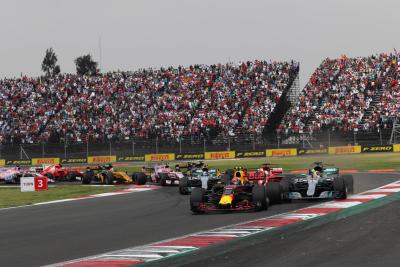FIA announces plans for simpler, louder F1 power units from 2021
The FIA has outlined initial plans for Formula 1's 2021 engine specification, retaining the V6 turbo hybrid power units currently used while making them simpler and louder.
Following heavy and sustained criticism of the current specification of power units introduced to F1 back in 2014, the FIA and F1 technical boss Ross Brawn have been working with manufacturers and other stakeholders to define the future engine plans.
The FIA has outlined initial plans for Formula 1's 2021 engine specification, retaining the V6 turbo hybrid power units currently used while making them simpler and louder.
Following heavy and sustained criticism of the current specification of power units introduced to F1 back in 2014, the FIA and F1 technical boss Ross Brawn have been working with manufacturers and other stakeholders to define the future engine plans.
A push for a simpler and louder engine formula has been present from all parties involved, leading to a meeting in Paris on Tuesday where the following details were presented as being the FIA and F1's vision for the 2021 engines:
Manufacturer representatives were presented with the vision for the key new features of the 2021 Power Unit proposed by the FIA and F1. These are as follows:
- 1.6 Litre, V6 Turbo Hybrid
- 3000rpm higher engine running speed range to improve the sound
- Prescriptive internal design parameters to restrict development costs and discourage extreme designs and running conditions
- Removal of the MGUH
- More powerful MGUK with focus on manual driver deployment in race together with option to save up energy over several laps to give a driver controlled tactical element to racing
- Single turbo with dimensional constraints and weight limits
- Standard energy store and control electronics
- High Level of external prescriptive design to give ‘Plug-And-Play’ engine/chassis/transmission swap capability
- Intention to investigate tighter fuel regulations and limits on number of fuels used
"In line with the objectives outlined by the FIA for the future of these regulations, which include a reduction in cost, maintaining road relevance with hybrid technology and improving the sound of the cars and the appeal for the fans, manufacturer representatives were presented with a roadmap for the development of the next generation of regulations," a statement from the FIA reads.
"The proposals shared today have been developed jointly by the FIA and by F1 using data and input from teams, power unit suppliers and outside experts, and the overall framework for the 2021 power unit definition will be in place and published by the FIA at the end of 2017.
"In order to uphold the objective of cost reduction, work will continue over the next 12 months to define certain elements of the Power Unit, but the design and development of the complete Power Unit will not be possible until all the information is released at the end of 2018. This aims to ensure that manufacturers continue to work on the current specification Power Unit.
"During the remaining part of 2017 and 2018, the FIA and F1 will also work with the teams to establish power unit test and development restrictions as well as other cost containment measures."
"The 2021 power unit is an example of the future way the FIA as regulators, F1 as commercial right holders, the teams and the manufacturers as stakeholders will work together for the common good of the sport," F1 managing director for motorsports Ross Brawn said.
"The proposal presented today was the outcome of a series of meeting which took place during 2017 with the current teams participating in the FIA Formula 1 World Championship and the manufacturers who showed their interest to be part of the pinnacle of motor sport.
"Also, we’ve carefully listened to what the fans think about the current PU and what they would like to see in the near future with the objective to define a set of regulations which will provide a powertrain that is simpler, cheaper and noisier and will create the conditions to facilitate new manufacturers to enter Formula 1 as powertrain suppliers and to reach a more levelled field in the sport.
"The new F1 has the target to be the world’s leading global sports competition married to state of the art technology. To excite, engage, and awe fans of all ages but to do so in a sustainable manner. We believe that the future power unit will achieve this."


![Johann Zarco, LCR, Honda RC213V, 2024 San Marino MotoGP, Misano, action [Gold & Goose]](https://cdn.crash.net/styles/thumbnail/s3/2024-09/GnG_1166323_HiRes.jpg?itok=vpgrU7Q4)

![Jack Miller, KTM Factory Racing, KTM RC16, San Marino MotoGP, Misano, action [Gold & Goose]](https://cdn.crash.net/styles/thumbnail/s3/2024-09/GnG_1167624_HiRes.jpg?itok=iz7mA4EQ)


![Fabio Quartararo, Monster Energy Yamaha Racing, Yamaha M1, 2024 MotoGP, Misano Test, action [Gold & Goose]](https://cdn.crash.net/styles/thumbnail/s3/2024-09/GnG_1168928_HiRes.jpg?itok=fcYSole_)
![Toprak Razgatlioglu, ROKiT BMW Motorrad, BMW M 1000 RR, Magny-Cours, WorldSBK [Gold & Goose]](https://cdn.crash.net/styles/thumbnail/s3/2024-09/GnG_1165133_HiRes.jpg?itok=GD5SVNVG)

